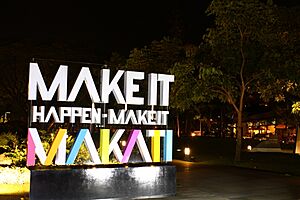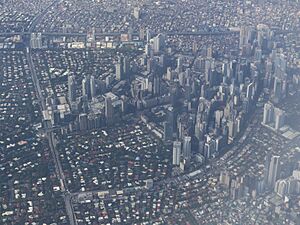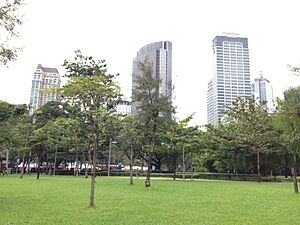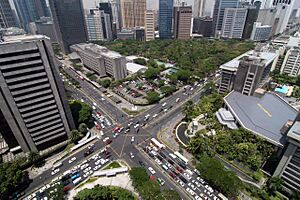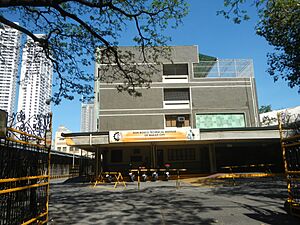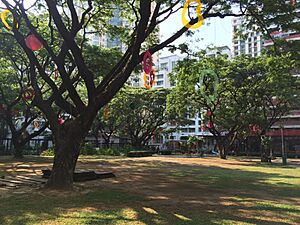Makati Central Business District facts for kids
Quick facts for kids
Makati Central Business District
|
||
|---|---|---|
|
Central Business District
|
||
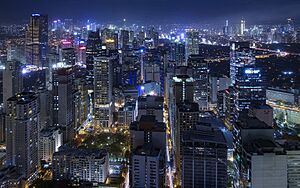 |
||
|
||
| Nickname(s):
The Financial Capital of the Philippines
|
||
 |
||
| Country | Philippines | |
| Region | National Capital Region | |
| City | Makati | |
| Time zone | UTC+8 (PST) | |
| Area code(s) | 2 | |
| Website | Make It Makati | |
The Makati Central Business District (Makati CBD) is a very important financial and business area in the Philippines. It is located in the heart of Makati in Metro Manila. This area is often called the "Central Cluster" within Makati. It is different from the city's government center, which is in Makati Poblacion.
Many tall buildings, known as skyscrapers, are found here. The Makati CBD is also one of the busiest commercial areas in Southeast Asia. It is home to the Ayala Center, which is a huge shopping and entertainment hub. Two groups, the Makati Commercial Estates Association (MaCEA) and the Ayala Property Management Corporation (APMC), help manage this important district.
Contents
Discovering Makati's Past
How Makati Began
Downtown Makati started a long time ago as part of a bigger area called Santa Ana de Sapa. In 1670, it became its own town, named San Pedro de Macati. This name honored its patron saint, Saint Peter.
In 1851, a man named Don José Bonifacio Roxas bought a large farm estate. This estate was called "Hacienda San Pedro de Macati." The western part of this farm is now what we call downtown Makati. Since then, the Ayala-Roxas family has been closely involved in Makati's growth.

In 1901, the Americans made the area south of the Pasig River a US military zone. This included the Hacienda San Pedro de Macati. This area became Fort William McKinley, now known as Fort Bonifacio. In the same year, Makati, with about 25,000 people, became part of the province of Rizal.
In the 1930s, the first airport on Luzon island, Nielson Field, opened. It was located where the Ayala Triangle is today. The airport officially opened in 1938. Philippine Airlines started flying from there in 1941. Train tracks also reached the town early in this decade.
After World War II
After World War II, Makati grew very quickly. Land prices went up a lot. When Nielson Field closed in 1948, plans were made to build a central business district. The first planned communities were set up in the 1950s. Some of these areas, like Urdaneta, San Lorenzo, San Antonio, and Bel-Air Villages, became commercial centers and office parks.
Ayala Avenue, a wide road with many lanes, was finished in 1958. This road was once part of the Nielson Airport runway. The downtown area was developed with specific rules for building homes and businesses. In the early 1960s, Ayala Corporation built some of the first tall buildings along Ayala Avenue.
The Makati Stock Exchange (MkSE) opened on May 27, 1963. It was located along Ayala Avenue. For almost 30 years, the MkSE and the Manila Stock Exchange were separate. But on December 23, 1992, they joined to become the Philippine Stock Exchange we know today.
Since the late 1960s, downtown Makati has been the financial heart of the Philippines. This happened because Manila became too crowded and expensive. The Makati Commercial Center was built in the 1960s. Makati developed fast under mayors Maximo Estrella and Jose Luciano. They encouraged new businesses and investors to come to the town.
The Martial Law Period
In 1972, President Ferdinand Marcos declared Martial law in the Philippines. Even with martial law, business continued in downtown Makati. In 1975, Makati officially became part of Metro Manila. This ended its time as a town in Rizal Province.
After a major political event in 1983, downtown Makati became a place for many rallies and protests. These protests helped lead to the People Power Revolution in 1986. This revolution aimed to end the Marcos government. During this time, the Makati Business Club became a voice against the government. This group of business leaders organized protests. These were sometimes called the Confetti Revolution. People would throw yellow confetti from buildings along Ayala Avenue during the rallies.
Growth in the Late 1980s and 1990s
After the People Power Revolution, Jejomar Binay became the acting mayor of Makati. He was later elected mayor in 1988. During his first term, the district was affected by a coup attempt in December 1989.
In the 1990s, the country's first skyscrapers began to rise in the business district. These included the Pacific Star Building and the Rufino Pacific Tower. In 1995, Makati officially became a city. This was a big celebration for the people and businesses in downtown Makati.
Makati in the 21st Century
In the early 2000s, downtown Makati was a common place for political rallies. It also experienced some attacks. In 2000, a bomb exploded at Glorietta inside Ayala Center, injuring people. Later, from 2000 to 2001, many protests against former president Joseph Estrada took place on Ayala Avenue.
In 2003, the Oakwood mutiny happened at the Oakwood Premier. In 2007, the Manila Peninsula siege took place at The Peninsula Manila. Both events happened in the Makati CBD. They were protests calling for former president Gloria Macapagal Arroyo to step down.
The 2007 Glorietta explosion happened at Glorietta 2 in October 2007. It caused 11 deaths and 120 injuries. It was later found that a faulty gas tank caused the explosion.
In 2011, the "Occupy Philippines" movement held protests in Makati. They marched from the Ninoy Aquino monument on Ayala Avenue. This movement was about economic inequality. In 2014, Makati started a tourism campaign called "Make it Happen, Make it Makati." This campaign promotes tourism in the business district.
Makati's Key Areas
The Makati Central Business District is located within four areas of Makati. These areas are called barangays.
Barangay Bel-Air
Barangay Bel-Air is a wealthy area and one of the richest barangays in the Philippines. It was established in the early 1950s. It includes Ayala North, Buendia Area, Ayala Triangle, and Salcedo Village. This area has both homes and many commercial buildings.
Bel-Air Village was the third neighborhood developed by Ayala. It started in 1957. The village has many residential lots.
Ayala Triangle is a sub-district in Downtown Makati. It is located between Ayala Avenue, Makati Avenue, and Paseo de Roxas. The Ayala Triangle Gardens is like Makati's Central Park. It is a green space in the middle of the business district. This area also has the Makati Stock Exchange and the Ayala Tower One.
Salcedo Village is a business park built by Ayala Corporation. It is named after two Spanish explorers, Juan and Felipe de Salcedo. It is home to tall office buildings like the PBCom Tower. You can also find the Salcedo Community Market here.
Ayala North is an area with many buildings. It includes Alphaland Makati Place and The Columns Ayala Avenue. The BIR Regional Office and the FEU Makati Campus are also located here.
Buendia Area is named after the former name of Gil Puyat Avenue. It is home to the headquarters of the Department of Trade and Industry and the Department of Tourism. Many commercial buildings are along Gil Puyat Avenue. The Buendia MRT station serves this area.
Barangay San Antonio
Barangay San Antonio is named after Saint Anthony of Padua. It used to be called Barrio Camachile. It has a mix of residential and commercial areas.
San Antonio Village is a residential area in the northern part of the barangay. It is home to schools like San Antonio National High School. The National Shrine of the Sacred Heart and the Makati Central Police Headquarters are also here. Former Vice President Jejomar Binay and his family live in this village.
San Antonio South is a busy area with many homes and businesses. It has tall residential and commercial buildings. The Makati Central Fire Station and Makati Central Post Office are also located here.
Barangay San Lorenzo
Barangay San Lorenzo is considered one of the richest barangays in the Philippines. This is because a big part of the Central Business District is located here. It was established in the 1950s and is one of the oldest areas.
Ayala Center is a huge commercial area run by Ayala Land. It is a top shopping and cultural spot in Metro Manila. The area includes the Glorietta and Greenbelt shopping malls. The Ayala MRT station also serves this area. This lifestyle hub is a major shopping destination in the Philippines. It also has many fancy hotels.
Legazpi Village is another business park built by the Ayala Corporation. It is named after Miguel López de Legazpi, a Spanish explorer. This area is home to the Asian Institute of Management. You can also find the Washington SyCip Park and Legazpi Active Park here.
San Lorenzo Village is a residential village. It is located south of Legazpi Village and Ayala Center. Assumption College San Lorenzo is located here.
Barangay Urdaneta
Barangay Urdaneta is the smallest barangay in the Central Cluster. It was one of the first planned communities, along with Forbes Park, San Lorenzo, and Bel-Air. It was established in the 1950s by the Ayala Family.
Roxas Triangle is an important intersection of major streets. The offices of the Development Bank of the Philippines and Metropolitan Bank and Trust Company are here. The Mandarin Oriental Manila and Roxas Triangle Towers are also in this area.
Apartment Ridge is a group of apartment and condominium buildings. The Peninsula Manila and Discovery Primea are located in this area.
Urdaneta Village is a quiet residential gated community within its barangay. The barangay is named after this subdivision.
Makati's Economy
Major Companies and Businesses
Many famous law firms, construction companies, and stock brokerages have their main offices here. Big companies like Ayala Corporation and Metropolitan Bank and Trust Company are headquartered in downtown Makati. Many companies listed on the PSE Composite Index also have their main offices here. These include Ayala Land, Banco de Oro, and PLDT.
Many banks also have their main offices in this area. These include China Banking Corporation, Development Bank of the Philippines, and HSBC Philippines. Makati is also a major center for newspaper publications. The Inquirer Group, which owns the Philippine Daily Inquirer, has its headquarters here. MediaQuest Holdings, a large media company, is also based here. They own TV5, Cignal TV, and newspapers like BusinessWorld and The Philippine Star. Smart Communications, a big mobile phone and internet company, is also headquartered in the district.
Ayala Automotive Holdings Corporation, a part of Ayala Corporation, is the largest car company in the country. Its main offices are in the district. This company manages the operations of Honda, Isuzu, and Volkswagen in the Philippines.
Until 2018, the Philippine Stock Exchange Headquarters was located in the CBD. It then moved to Bonifacio Global City in Taguig.
International Companies
More than a hundred multinational companies have regional headquarters and operations in Makati. Most of these are within the CBD. Some examples include Intel, Microsoft, Nestlé, Shell, and Accenture. Many call centers are also present in the area, such as Teletech and Convergys.
Places to Visit and Learn
Healthcare
The Makati CBD is home to the Makati Medical Center. This is a private hospital and one of the largest healthcare companies in the country. The district also has the Makati Life Medical Center.
Education
Several libraries are open to the public in Makati. The Filipinas Heritage Library is a famous library located in Ayala Triangle.
The district also has many well-known schools and colleges. Some of the top universities in the Philippines are located downtown. These include:
- Asia Pacific College
- Asian Institute of Management
- Assumption College San Lorenzo
- Centro Escolar University Makati
- De La Salle University – Makati Campus
- Far Eastern University - Makati
- Lyceum of the Philippines University – Makati
Shopping Centers
Makati CBD is famous for its shopping. Here are some of the major shopping centers:
- Ayala Malls One Ayala
- Greenbelt
- Makati Central Square
- Glorietta
- Landmark
- Rustan's Makati
- SM Makati
Parks & Museums
The CBD also offers many parks and museums where you can relax and learn:
- Ayala Museum
- Ayala Triangle Gardens
- Bel-Air Park
- Dolphin Park
- Glorietta 3 Park
- Greenbelt Park
- Jaime Velasquez Park
- Legazpi Active Park
- Makati Sports Club
- San Lorenzo Clubhouse
- Urdaneta Park
- Washington Sycip Park
- Yuchengco Museum
Getting Around Makati CBD

Downtown Makati is easy to reach. Many people use affordable jeepneys and buses to get around. Most buses and jeepneys come from EDSA, a main road in Metro Manila. Ayala Center is a major public transport hub. Here, different jeepneys, UV Express vans, and buses stop. It is also close to the MRT station.
There are also special point-to-point bus stops, especially in Legazpi Village, Glorietta, and One Ayala. You can also find intercity buses that go from Ayala Center to Bonifacio Global City. There are many parking buildings for cars. Taxis are also available.
Because it is a leading business district, it sometimes has traffic congestion. The Metropolitan Manila Development Authority (MMDA) helps manage traffic. To reduce traffic, they use a system called Unified Vehicular Volume Reduction Program. This means certain cars cannot be on the road on certain days.
The downtown district is served by major roads and expressways:
 : Epifanio delos Santos Avenue
: Epifanio delos Santos Avenue : Osmeña Highway
: Osmeña Highway : Gil Puyat Avenue
: Gil Puyat Avenue
Expressways
 : Skyway
: Skyway : South Luzon Expressway
: South Luzon Expressway
You can also reach the CBD using the Manila Metro Rail Transit System (MRT). The following stations serve the area:
- Buendia MRT station
- Ayala MRT station
- Magallanes MRT station
A new Makati Intra-city Subway is also being built. It will have two stations in the CBD: Mile Long–Amorsolo and Buendia.



